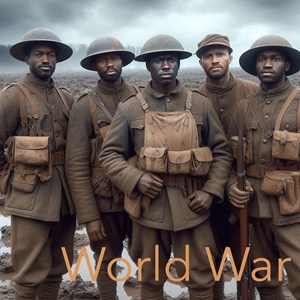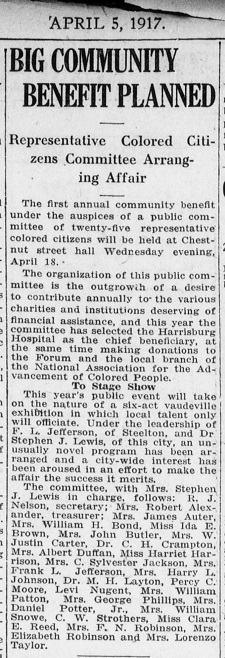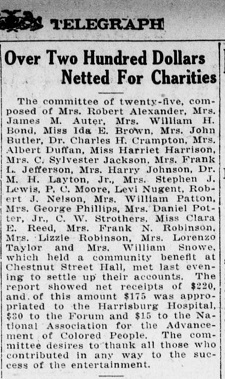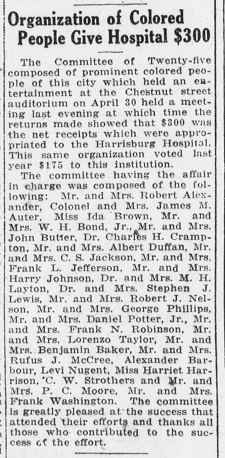 Enslavement
Enslavementto freedom


Moving Through and Meeting the Challenges
of the Twentieth Century
Study Areas
Harrisburg's African American
Committee of Twenty-Five
Service and Sacrifice in the Face of Impending War
Harrisburg's African American community was called upon for sacrifice and patriotism in the buildup to America's involvement in World War I. Despite the persistence of crippling institutionalized racism, the Black community was expected to respond to the war emergency with resources, men and money. These demands came at a time when many African Americans in the north were just beginning to create inroads in commercial, social and political circles. Harrisburg's African American community did not balk at these expectations, however, and responded effectively. The Committee of Twenty-Five, described below, is one example of the significant support Harrisburg Blacks provided to the wider central Pennsylvania civic community.
Excluded from white-controlled institutions, African American communities quickly became adept at organizing their own self-help resources. Whether these were churches, schools, adult education classes, social clubs, burial societies, or any of hundreds of other resources, African American communities developed and even thrived in the post-enslavement era largely due to home-grown provincial self-help groups.
 Harrisburg's African American community was firmly established socially by the dawn of the Progressive Era, having grown substantially with the influx of southern Blacks, attracted by steel mill and manufacturing jobs in the industrial corridor that stretched south into Steelton. Harrisburg's position as a transportation hub added the promise of railroad jobs and all of the services needed to support them. Evidence of thriving African American communities that could boast of successful business leaders and a vibrant entrepreneureal atmosphere, not only in Harrisburg but throughout the state, was documented by Harrisburg publisher James H. W. Howard, whose 1910 Pennsylvania Negro Business Directory, Illustrated, listed hundreds of successful African American business leaders.
Harrisburg's African American community was firmly established socially by the dawn of the Progressive Era, having grown substantially with the influx of southern Blacks, attracted by steel mill and manufacturing jobs in the industrial corridor that stretched south into Steelton. Harrisburg's position as a transportation hub added the promise of railroad jobs and all of the services needed to support them. Evidence of thriving African American communities that could boast of successful business leaders and a vibrant entrepreneureal atmosphere, not only in Harrisburg but throughout the state, was documented by Harrisburg publisher James H. W. Howard, whose 1910 Pennsylvania Negro Business Directory, Illustrated, listed hundreds of successful African American business leaders.
Howard's publication was impressive and seemed to be positive proof of Booker T. Washington's assertion that African Americans should develop their own skills and businesses to become productive citizens. But the counter-argument advocating constant agitation for equal rights, advanced by W.E.B. DuBois and embraced by many of Harrisburg's leading Black citizens, was gaining strength. The cause described in the article to the right exhibits some of each view. Twenty-five leading Black citizens of Harrisburg and Steelton organized in the impending shadow of world war to raise funds to support the city hospital and another organization listed as the "Forum" (not the circa 1930 Forum Building).
This effort, as the article notes, was "the outgrowth of a desire to contribute annually to the various charities and institutions deserving of financial assistance." This show of good citizenry was very much in the spirit of Booker T. Washington's beliefs, but the influence of W.E.B. DuBois is also seen in the addition of the NAACP as a secondary beneficiary. That organization, begun in 1909, used the activist ideals of DuBois' Niagara Movement to fight for rights for African Americans guaranteed in the 13th, 14th and 15th Amendments.
The first members of this committee, as listed in the article, were: R. J. Nelson, secretary; Mrs. Robert Alexander, treasurer; Mrs. James Auter, Mrs. William H. Bond, Miss Ida E. Brown, Mrs. John Butler, Mrs. W. Justin Carter, Dr. C. H. Crampton, Mrs. Albert Duffan, Miss Harriet Harrison, Mrs. C. Sylvester Jackson, Mrs. Frank L. Jefferson, Mrs. Harry L. Johnson, Dr. M. H. Layton, Percy C. Moore, Levi Nugent, Mrs. William Patton, Mrs. George Phillips, Mrs. Daniel Potter, Jr., Mrs. William Snowe, C. W. Strothers, Miss Clara E. Reed, Mrs. F. N. Robinson, Mrs. Elizabeth Robinson and Mrs. Lorenzo Taylor.
Source: Telegraph (Harrisburg, PA), April 5, 1917, p. 15.

The article at left reports the results of the first benefit, with net proceeds of $220. Of that, the committee allocated $175 to Harrisburg Hospital, $30 to the Forum, and $15 to the local NAACP chapter.
Source: Telegraph (Harrisburg, PA), April 25, 1917, p. 6.

The benefit was repeated the following year, with even greater results, netting $300, all of which was donated to Harrisburg Hospital.
Source: Telegraph (Harrisburg, PA), May 8, 1918, p. 4.